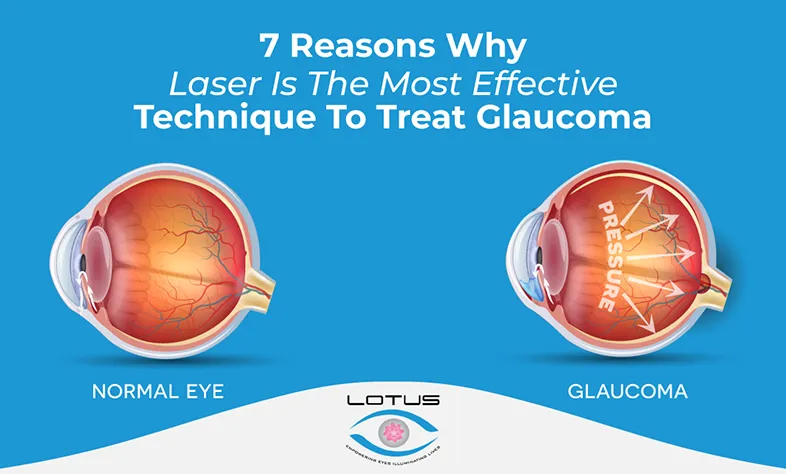7 Reasons Why Laser Is The Most Effective Technique To Treat Glaucoma

Glaucoma has an infamous reputation in the realm of eye care. Specialists and experts call it the silent thief of vision. It isn’t until the later stages that the disease is identified, and that’s when glaucoma treatment begins in earnest.
What is Glaucoma?
Glaucoma is a family of eye disorders that cause blindness by placing pressure on the optic nerve. This gradual rise in pressure eventually damages the optic nerve beyond repair, which causes the irreversible, permanent blindness that is characteristic of glaucoma. Glaucoma is classified based on the type of pressure that causes optic nerve damage. The disorder is more prevalent in elderly people, and the only way to treat it is through preventive measures.
At the first telltale sign of glaucoma, it’s vital to seek a proper medical diagnosis from an ophthalmologist at a reputed clinic, to take stock of the situation. To better identify glaucoma, however, one has to understand what causes the disease, and any risk factors associated with the disorder. In the interest of staying well-informed, let’s examine the symptoms of a typical case of glaucoma, and what actually causes them.
What Are The Symptoms of Glaucoma
Possibly the most ominous (and well-known) symptom of glaucoma is the irreversible blindness it causes. Glaucoma eye diseases are a group of disorders that come with common characteristic symptoms. This stems from the buildup of pressure in the eyeball, which is characteristic of the disorder. While the symptoms are hard to identify at the earlier stages, there exist some telltale signs that can assist with the diagnosis. Let’s take a look at them individually.
Open-Angle Glaucoma
This variant of glaucoma is the most common and is known for its gradual onset of symptoms. It usually only affects elderly people.
Angle-Closure Glaucoma
The symptoms are markedly severe, and a lot more pronounced. Once contracted, the symptoms are acute, and are more than an inconvenience, severely impairing the person’s day-to-day life at times. Some of the symptoms are:
If you exhibit any of these symptoms, don’t hesitate to consult a glaucoma specialist at a reputed eye clinic.
What Are The Causes of Glaucoma?
As mentioned before, glaucoma is a family of similar disorders that tie back to a root cause: increased pressure in the eyeball, which damages the optic nerve. The differences that distinguish the types of glaucoma are based on how the pressure arises in the eye. Each type of glaucoma exhibits distinct symptoms, which come with a unique cause. On closer scrutiny of the classification, we can see that:
When the set of intricate tissue (trabecular meshwork) that drains aqueous humour fluid from the eye is obstructed, it causes open-angle glaucoma. This, in turn, gradually increases the pressure on the optic nerve, damaging it irreversibly and causing blindness. The statistics show that this type of glaucoma is the most common, and that elderly people are the most affected. A glaucoma test can help identify this variant of glaucoma before any significant harm is done. Your eye specialist will prescribe the test.
In angle-closure glaucoma, the intraocular pressure arises due to significant protrusion from the iris. The protrusion restricts the space for fluid to drain between the cornea and iris, subsequently raising the pressure in the eyeball and damaging the optic nerve. In some people, the angle of closure between the cornea and iris is narrow by default, placing them at a higher risk of glaucoma. As mentioned before, this is a more severe form of glaucoma, in the sense that its symptoms manifest themselves much more rapidly.
There are other associated causes and risk factors associated with glaucoma, such as normal-tension glaucoma. The exact cause for such types is relatively unclear. Still, the root cause of the actual repercussions of glaucoma is the irreparable damage to the optic nerve. Since the optic nerve is nervous tissue, once damaged, it does not regenerate. And since the optic nerve is the singular link to the brain, any damage leads to permanent vision loss. The complete loss of sight is the single biggest factor that makes glaucoma such a threat in terms of eye ailments.
Treatment of Glaucoma?
The conventional method of glaucoma treatment has been eye drops. Once contracted, treatment for glaucoma is usually lifelong, because even if the symptoms recede, they may resurface. The eye drops work on the principle of curbing the amount of fluid the eye produces, thereby reducing intraocular pressure. The existing damage caused by glaucoma cannot be undone, so the disease must be detected at the earliest. In recent times, laser treatment has emerged as a viable alternative to treating glaucoma. Here are seven reasons why selective laser trabeculoplasty (SLT) is a viable technique to treat glaucoma.
How is Glaucoma Diagnosed?
Is Glaucoma Curable?
The fact of the matter is, there is no way to cure the damage that glaucoma causes to your optic nerve. Any vision loss that occurs due to glaucoma is permanent. Cures for glaucoma essentially deal with preventing it from reaching the point of causing permanent blindness. By stopping the buildup of high eye pressure through drops or laser treatment, you can keep glaucoma at bay.
So to ward off glaucoma, make sure you go for regular checkups at a reputed eye clinic to check for the disorder. If you exhibit any signs, go and have it examined by your doctor. Glaucoma treatment is the best example of better late than never!